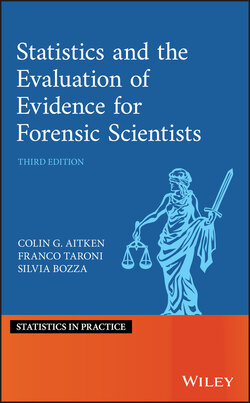Читать книгу Statistics and the Evaluation of Evidence for Forensic Scientists - Franco Taroni - Страница 36
1.7.9 Dependent Events and Background Information
ОглавлениеConsider, one roll of a fair die with , the throwing of an odd number as before, and , the throwing of a number greater than 3, as before. Then, but and Event and are said to be dependent.
The third law of probability for dependent events was first presented by Bayes (1763) (see also Barnard 1958; Pearson and Kendall 1970; Poincaré 1912). It is the general law for the conjunction of events. Before the general statement of the third law is made, some discussion of dependence is helpful.
It is useful to consider that a probability assessment depends on two things: the event whose probability is being considered and the information available when is being considered. The probability is referred to as a conditional probability, acknowledging that is conditional or dependent on . Note the use of the vertical bar . Events listed to the left of it are events whose probability is of interest. Events listed to the right are events whose outcomes are known and which may affect the probability of the events listed to the left of the bar, the vertical bar having the meaning ‘given’ or ‘conditional on’.
Consider a defendant in a trial who may or may not be truly guilty. Denote the event that they are truly guilty by . The uncertainty associated with their true guilt, the probability that they are truly guilty, may be denoted by . It is a subjective probability. The uncertainty will fluctuate during the course of a trial. It will fluctuate as evidence is presented. It depends on the evidence. Yet neither the notation, , nor the language, the probability of true guilt, makes mention of this dependence. The probability of true guilt at any particular time depends on the knowledge (or information) available at that time. Denote this information by . It is then possible to speak of the probability of true guilt given, or conditional on, the information available at that time. This is written as . If additional evidence is presented this then becomes, along with , part of what is known. What is taken as known is then ‘ and ’, the conjunction of and . The revised probability of true guilt is . If the information concerns individual at time as in Section 1.7.5 the probability can be written as .
All probabilities should be thought of as conditional probabilities. Personal experience informs judgements made about events. For example, judgement concerning the probability of rain the following day is conditioned on personal experiences of rain following days with similar weather patterns to the current one. Similarly, judgement concerning the value of evidence or the guilt of a PoI is conditional on many factors. These include other evidence at the trial but may also include a factor to account for the perceived reliability of the evidence. There may be eyewitness evidence that the PoI was seen at the scene of the crime but this evidence may be felt to be unreliable. Its value will then be lessened.
The value of scientific evidence will be conditioned on the background data relevant to the type of evidence being assessed. Evidence concerning frequencies of different DNA profiles will be conditioned on information regarding ethnicity of the people concerned for the values of these frequencies. Evidence concerning distributions of the refractive indices of glass fragments will be conditioned on information regarding the type of glass from which the fragments have come (e.g. building window, car headlights etc.). The existence of such conditioning events will not always be stated explicitly. However, they should not be forgotten. As stated above, all probabilities may be thought of as conditional probabilities. The first two laws of probability can be stated in the new notation, for events and information as:
